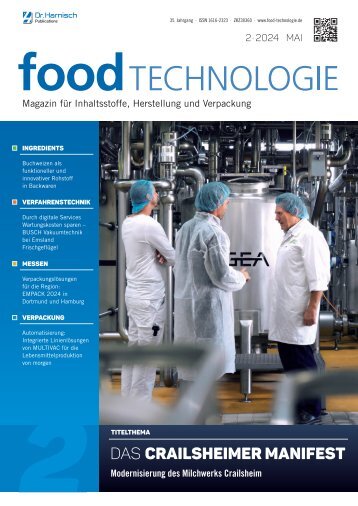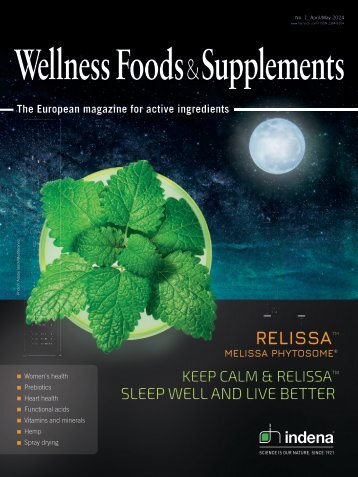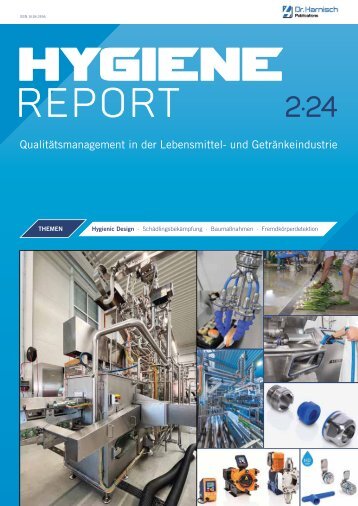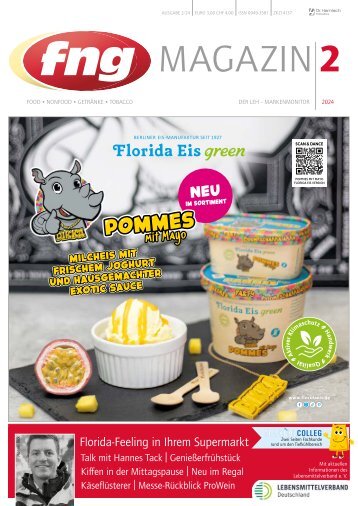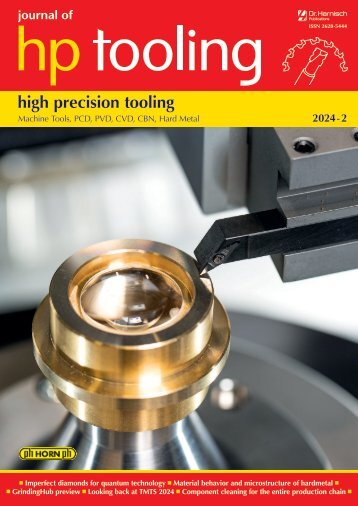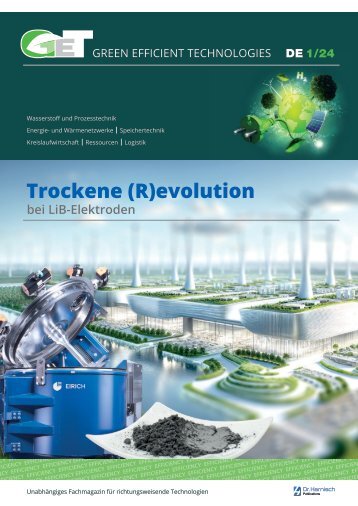GET – GREEN EFFICIENT TECHNOLOGIES – English Language
- Text
- Harnischcom
- Materials
- Valve
- Electricity
- Grid
- Valves
- Technologies
- Efficient
- Pumps
- Hydrogen
- Efficiency
Components Elastomer
Components Elastomer seals and biological fluids Is organic the solve-all solution? Applying elastomer seals with biogenic media Dipl.-Ing. (FH) Michael Krüger An ever-increasing number of biogenic fluids are being used in wide- reduce CO 2 emissions is also becom- protect the climate protection and ranging technical applications. Soaring numbers in fact. And for many Moves like this also help wean peoing an increasingly crucial argument. different reasons. Despite an applicable scope ranging from the che- products described are renewable ple off petroleum, since most of the mical process industry and related raw materials. Ultimately, though, the elements to usage in forestry, agriculture and water management, helping a range of biogenic media key thing making the difference and deploying these biogenic media break through may have been legislation in the form of EU directives. poses an enormous challenge to elastomer seals. Many public tenders, for example, prescribe the use of biogenic fluids in Biological fluids are environmentally construction vehicles. friendly, rapidly biodegradable and Even so, hurdles remain to the non-toxic media, most often produced from biomass. But why are ids with existing mineral oil-based wholesale replacement of such flu- more people using such fluids and media. For many components, some what is the main motivation? As well of the effects remain unknown and as the move to a greener approach numerous elastomer seals are also and avoid vehicles contaminating unsuitable for this application. Here, soil or bodies of water, the need to carburettor fuel E10 is introduced as Fig. 1: Biodegradable hydraulic fluids in mobile hydraulics. Photo: Fotolia/GHotz a result of regulatory market interventions and similarly, it triggers a different response in many components compared to conventional petrol. Accordingly, this impacts on the entire chemical process industry, directly and indirectly, when producing, storing and transporting media like these. Issues when deploying hydraulic fluids in sensitive ecosystems Generally speaking, the greenest fluid solutions involve no fluid escaping from machinery in the first place. But however cutting-edge the machines in place, leaks can still contaminate bodies of water and soil when stationary hydraulic systems like locks, weirs and hydroelectric power plants are used. The same applies when operating construction machinery, piste equipment in the mountains, and agriculture and forestry equipment. The key here is ensuring the hydraulic fluids and lubricants are free of substances with a critical ecotoxicological impact. This explains the increasing use of biodegradable hydraulic fluids in hydraulic drive technology. Beware however - they can severely attack conventional FKM seals and render long-term use virtually impossible. Biodegradable hydraulic fluids comprise either triglycerides, which are often vegetable oils (e.g. rapeseed oil) called HEES (hydraulic environmental ester synthetic) or synthetic esters known as HEES. These fluids are designated as class I pollutants. In modern hydraulics, more and more special high-performance hydraulic fluids are also being used. While they contain additives, they are not based on mineral oil. These substances constitute synthetic, anhydrous liquids (HFD), which have a higher density than mineral oil and are flame retardant. Examples include 32 GREEN EFFICIENT TECHNOLOGIES 2022
Components Elastomer seals and biological fluids Fig. 2: Sealing challenge for fuels with bio content phosphoric acid esters (HFD-R), anhydrous chlorinated hydrocarbons (HFD-S) or a mixture of HFD-R and HFD-S, and anhydrous other compositions (HFD-U) comprising fatty acid esters. However, both biodegradable and synthetic hydraulic fluids attack conventional elastomeric sealing materials. A high-performance FKM compound must also be usable in all the areas mentioned without any issues and for the long term. Carburettor fuel E10 Despite the fact E10 fuel has already been around for some time, discussions remain ongoing about the 10% ethanol blend in commercial petrol (E10) - both among users and seal manufacturers. Elastomer seals that end up in permanent contact with the E10 carburettor fuel are not only found in cars of trucks powered by said fuel, but throughout the periphery of the production and transport chain of the same. Both manufacturers and logistics companies alike are plagued with problems due to the E10 carburettor fuel. In some cases, the maintenance intervals are extremely short, because the seals used to date lacked sufficient resistance. Impact on sealing materials Conventional sealing materials that have not been specifically designed to withstand contact with biogenic media can be adversely impacted in various ways when in permanent contact with these fluids. The physical properties of these sealing materials are prone to change, in volume for example (swelling) or the degree of hardness. Chemical resistance (e.g. through hydrolysis) may also be drastically reduced. Changes like these all cause the sealing properties to decline, considerably in some cases and will eventually lead to leakage and/or require premature seal replacement. New FKM material for use in biogenic media The independent manufacturer C. Otto Gehrckens GmbH (COG) has developed an FKM sealing material called "BF 750" tailored for such applications, which has proven its worth on numerous occasions. This material concerned is a 3rd-generation high-fluorine polymer based on fluororubber (FKM). This compound was specially developed by COG Compound Development to meet the most stringent demands of use in biogenic media, as well as being tested in an independent laboratory. Results exceeded all expectations – normal use saw practically no material changes occur. So the testing scope was extended to also include more unusual and extreme situations. Here too, the FKM BF 750 material performed admirably, achieving results far below any tolerance limit, as exemplified by the data below. The study also encompassed corresponding fuel blends with conventional fuels as well as purely biogenic fuels. As well as exceptional resistance to hot water and steam, the manufacturer claims this FKM material can also withstand all conventional fuels and many other media, like alcohols and acids. The BF 750 material developed can be deployed wherever sealing materials come into contact with the above-mentioned media. The applicable scope thus includes hydraulic components, pipes, lines, valves, petrol station dispensing systems and their peripherals, pumps, motors, couplings, vacuum pumps, boilers, autoclaves, hose seals among others. In other words, numerous and wide-ranging applications. GREEN EFFICIENT TECHNOLOGIES 2022 33
- Seite 1 und 2: GREEN EFFICIENT TECHNOLOGIES 2022 H
- Seite 3 und 4: Editorial Hydrogen in the atmospher
- Seite 5 und 6: HAMPRO® HIGH-PRESSURE PROCESS TECH
- Seite 7 und 8: HOW EFFICIENT IS YOUR HYDROGEN COMP
- Seite 9 und 10: Leading article combustible waste (
- Seite 11 und 12: NEW: THE ELECTRIC STEAM GENERATOR [
- Seite 13 und 14: Cover story Fig. 3: In the course o
- Seite 15 und 16: From the research Hydrogen operate
- Seite 17 und 18: From the research Hydrogen Hydrogen
- Seite 19 und 20: Pumps and systems Seawater desalina
- Seite 21 und 22: Driving the world Intelligent power
- Seite 23 und 24: Compressors and systems Hydrogen -
- Seite 25 und 26: Compressors and systems Biomethane
- Seite 27 und 28: Compressors and systems Biomethane
- Seite 29 und 30: Components Hydrogen energy from ful
- Seite 31: FILTECH Fig. 4: A total of eight en
- Seite 35 und 36: lit modular casing UMPE less steel,
- Seite 37 und 38: Components Radar sensor Fig. 3: The
- Seite 39 und 40: Components 3-phase decanter Fig. 2:
- Seite 41 und 42: Components Sustainable concrete the
- Seite 43 und 44: Trade fairs and events VALVE WORLD
- Seite 45 und 46: Trade fairs and events FILTECH 2023
- Seite 47 und 48: Companies - Innovations - Products
- Seite 49 und 50: Companies - Innovations - Products
- Seite 51 und 52: Companies - Innovations - Products
- Seite 53 und 54: Companies - Innovations - Products
- Seite 55 und 56: Brand name register NETZSCH Pumpen
- Seite 57 und 58: Come and see for yourself: www.harn
Unangemessen
Laden...
Magazin per E-Mail verschicken
Laden...
Einbetten
Laden...








































